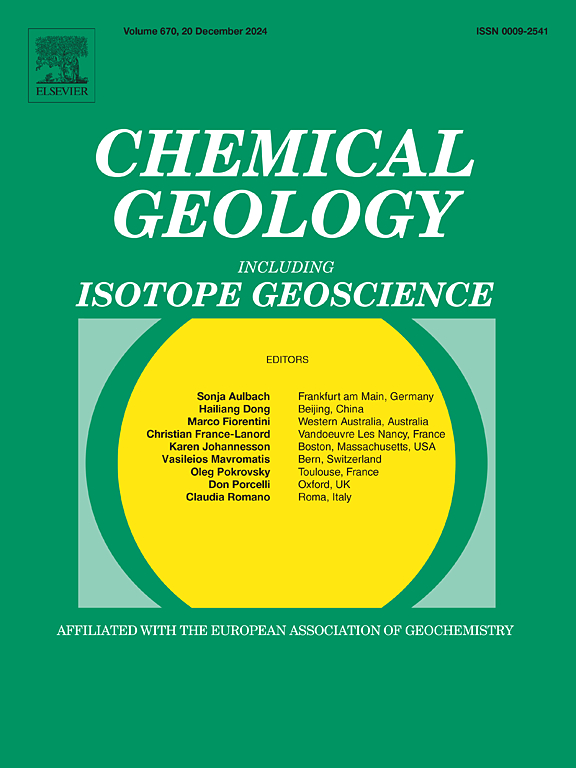The impact of burial diagenesis on soil-formed minerals in paleosols using stable isotopes of phyllosilicates and carbonate clumped isotopes
IF 3.6
2区 地球科学
Q1 GEOCHEMISTRY & GEOPHYSICS
引用次数: 0
Abstract
To understand the effects of burial diagenesis on the stable isotope geochemistry of soil-formed clay and carbonate minerals in paleosols, samples were collected from seven cores, spanning middle- to upper-Pennsylvanian strata of the Illinois Basin, with varied maximum burial depths of 1–3 km. Mixed-layer illite-smectite and kaolinite mixtures give δ2H and δ18O values of −83 ‰ to −36 ‰ and 11.9 ‰ to 21.1 ‰ (VSMOW), respectively. After carbonates were screened petrographically for diagenetic textures using transmitted light and cathodoluminescence, measured clumped isotope Δ47 values range from 0.504 to 0.563 ‰ (I-CDES). Resulting mineral formation temperatures for phyllosilicate mineral mixtures are 28 to 66 °C (mean = 47 °C), whereas T(Δ47) estimates for calcites are 36 to 61 °C (mean = 45 °C). Calculated δ18Owater values from which phyllosilicate minerals and calcites precipitated under isotopic equilibrium ranges from −7.1 to −1.2 ‰ and − 1.4 to +4.9 ‰, respectively. Closed and open-system phyllosilicate-fluid exchange modeling indicates that phyllosilicate alteration occurred in the presence of a low temperature brine or meteoric water and is interpreted to occur in a layer-by-layer illitization transformation. Due to the lack of diagenetic textures and positively correlated T(Δ47) and δ18Owater, calcites are interpreted to have undergone solid-state bond reordering. Despite low to moderate temperatures (<125 °C) and varying depths of shallow burial (1–3 km), solid-state transformation of phyllosilicates and calcites indicates paleosols had prolonged exposure to burial conditions which has implications for the use of paleosol minerals for paleoenvironmental reconstructions.
利用层状硅酸盐和碳酸盐团块同位素的稳定同位素研究埋藏成岩作用对古土壤中成土矿物的影响
为了了解埋藏成岩作用对古土壤中成土矿物稳定同位素地球化学的影响,在伊利诺伊盆地的7个岩心中采集了古土壤样品,这些岩心跨越中-上宾夕法尼亚地层,最大埋藏深度为1-3 km。混合层伊利石-蒙脱石和高岭石混合物的δ2H和δ18O值分别为- 83 ‰~ - 36 ‰和11.9 ‰~ 21.1 ‰(维也纳标准平均海水;分别VSMOW)。利用透射光和阴极发光技术对碳酸盐岩进行岩相筛选后,块状同位素Δ47测量值为0.504 ~ 0.563 ‰(I-CDES)。层状硅酸盐矿物混合物产生的矿物形成温度是28 - 66 °C(意味着 = 47 °C),而T(Δ47)估计存在方解石36到61 °C(意味着 = 45 °C)。在同位素平衡下,层状硅酸盐矿物和方解石沉淀的δ18Owater计算值分别为−7.1 ~−1.2‰和 − 1.4 ~ +4.9‰。封闭系统和开放系统层状硅酸盐-流体交换模型表明,层状硅酸盐蚀变发生在低温盐水或大气水存在的情况下,并解释为逐层illi石化转化。由于缺乏成岩结构和正相关的T(Δ47)和δ18Owater,方解石被解释为经历了固相键重排序。尽管温度低至中等(<125 °C)和浅埋深度不同(1-3 km),层状硅酸盐和方解石的固态转化表明古土壤长期暴露于埋藏条件下,这对利用古土壤矿物进行古环境重建具有重要意义。
本文章由计算机程序翻译,如有差异,请以英文原文为准。
求助全文
约1分钟内获得全文
求助全文
来源期刊

Chemical Geology
地学-地球化学与地球物理
CiteScore
7.20
自引率
10.30%
发文量
374
审稿时长
3.6 months
期刊介绍:
Chemical Geology is an international journal that publishes original research papers on isotopic and elemental geochemistry, geochronology and cosmochemistry.
The Journal focuses on chemical processes in igneous, metamorphic, and sedimentary petrology, low- and high-temperature aqueous solutions, biogeochemistry, the environment and cosmochemistry.
Papers that are field, experimentally, or computationally based are appropriate if they are of broad international interest. The Journal generally does not publish papers that are primarily of regional or local interest, or which are primarily focused on remediation and applied geochemistry.
The Journal also welcomes innovative papers dealing with significant analytical advances that are of wide interest in the community and extend significantly beyond the scope of what would be included in the methods section of a standard research paper.
 求助内容:
求助内容: 应助结果提醒方式:
应助结果提醒方式:


